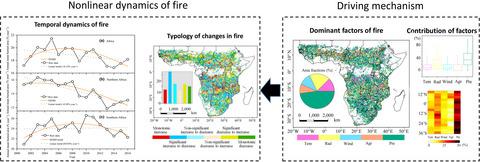当前位置:
X-MOL 学术
›
Glob. Change Biol.
›
论文详情
Our official English website, www.x-mol.net, welcomes your feedback! (Note: you will need to create a separate account there.)
Nonlinear dynamics of fires in Africa over recent decades controlled by precipitation.
Global Change Biology ( IF 11.6 ) Pub Date : 2020-05-23 , DOI: 10.1111/gcb.15190 Fangli Wei 1, 2 , Shuai Wang 3 , Bojie Fu 1, 2 , Martin Brandt 4 , Naiqing Pan 1, 2, 5 , Cong Wang 1, 2 , Rasmus Fensholt 4
Global Change Biology ( IF 11.6 ) Pub Date : 2020-05-23 , DOI: 10.1111/gcb.15190 Fangli Wei 1, 2 , Shuai Wang 3 , Bojie Fu 1, 2 , Martin Brandt 4 , Naiqing Pan 1, 2, 5 , Cong Wang 1, 2 , Rasmus Fensholt 4
Affiliation

|
Dynamics of fires in Africa are of critical importance for understanding changes in ecosystem properties and effects on the global carbon cycle. Given increasing fire risk from projected warming on the one hand and a documented human‐driven decline in fires on the other, it is still unknown how the complex interplay between climate and human factors affects recent changes of fires in Africa. Moreover, the impact of recent strong El Niño events on fire dynamics is not yet known. By applying an ensemble empirical mode decomposition method to satellite‐derived fire burned area, we investigated the spatio‐temporal evolution of fires in Africa over 2001–2016 and identified the potential dominant drivers. Our results show an overall decline of fire rates, which is continuous over the time period and mainly caused by cropland expansion in northern sub‐Saharan Africa. However, we also find that years of high precipitation have caused an initial increase in fire rates in southern Africa, which reversed to a decline in later years. This decline is caused by a high frequency of dry years leading to very low fuel loads, suggesting that recent drought causes a general reduction of burned areas, in particular in xeric savannas. In some mesic regions (10°–15°S), solar radiation and increased temperature caused increase in fires. These findings show that climate change overrules the impact of human expansion on fire rates at the continental scale in Africa, reducing the fire risk.
中文翻译:

近几十年来受降水控制的非洲火灾的非线性动态。
非洲的火灾动态对于了解生态系统特性的变化和对全球碳循环的影响至关重要。一方面,鉴于预计变暖导致火灾风险增加,另一方面有记录的人为驱动的火灾减少,气候和人为因素之间复杂的相互作用如何影响非洲最近的火灾变化仍是未知数。此外,近期强烈的厄尔尼诺事件对火灾动态的影响尚不清楚。通过将集合经验模态分解方法应用于卫星衍生的火灾烧毁区域,我们调查了 2001-2016 年非洲火灾的时空演变,并确定了潜在的主导驱动因素。我们的结果显示火灾率总体下降,这在一段时间内是连续的,主要是由撒哈拉以南非洲北部的农田扩张造成的。然而,我们还发现,多年的高降水量导致南部非洲的火灾率最初增加,后来又逆转为下降。这种下降是由于干旱年份频繁导致燃料负荷非常低,这表明最近的干旱导致燃烧面积普遍减少,特别是干旱稀树草原。在一些中间区域(10°–15°S),太阳辐射和温度升高导致火灾增加。这些发现表明,气候变化在非洲大陆范围内推翻了人类扩张对火灾率的影响,从而降低了火灾风险。我们还发现,多年的高降水量导致南部非洲的火灾率最初增加,后来又逆转为下降。这种下降是由于干旱年份频繁导致燃料负荷非常低,这表明最近的干旱导致燃烧面积普遍减少,特别是干旱稀树草原。在一些中间区域(10°–15°S),太阳辐射和温度升高导致火灾增加。这些发现表明,气候变化在非洲大陆范围内推翻了人类扩张对火灾率的影响,从而降低了火灾风险。我们还发现,多年的高降水量导致南部非洲的火灾率最初增加,后来又逆转为下降。这种下降是由于干旱年份频繁导致燃料负荷非常低,这表明最近的干旱导致燃烧面积普遍减少,特别是干旱稀树草原。在一些中间区域(10°–15°S),太阳辐射和温度升高导致火灾增加。这些发现表明,气候变化在非洲大陆范围内推翻了人类扩张对火灾率的影响,从而降低了火灾风险。在一些中间区域(10°–15°S),太阳辐射和温度升高导致火灾增加。这些发现表明,气候变化在非洲大陆范围内推翻了人类扩张对火灾率的影响,从而降低了火灾风险。在一些中间区域(10°–15°S),太阳辐射和温度升高导致火灾增加。这些发现表明,气候变化在非洲大陆范围内推翻了人类扩张对火灾率的影响,从而降低了火灾风险。
更新日期:2020-07-13
中文翻译:

近几十年来受降水控制的非洲火灾的非线性动态。
非洲的火灾动态对于了解生态系统特性的变化和对全球碳循环的影响至关重要。一方面,鉴于预计变暖导致火灾风险增加,另一方面有记录的人为驱动的火灾减少,气候和人为因素之间复杂的相互作用如何影响非洲最近的火灾变化仍是未知数。此外,近期强烈的厄尔尼诺事件对火灾动态的影响尚不清楚。通过将集合经验模态分解方法应用于卫星衍生的火灾烧毁区域,我们调查了 2001-2016 年非洲火灾的时空演变,并确定了潜在的主导驱动因素。我们的结果显示火灾率总体下降,这在一段时间内是连续的,主要是由撒哈拉以南非洲北部的农田扩张造成的。然而,我们还发现,多年的高降水量导致南部非洲的火灾率最初增加,后来又逆转为下降。这种下降是由于干旱年份频繁导致燃料负荷非常低,这表明最近的干旱导致燃烧面积普遍减少,特别是干旱稀树草原。在一些中间区域(10°–15°S),太阳辐射和温度升高导致火灾增加。这些发现表明,气候变化在非洲大陆范围内推翻了人类扩张对火灾率的影响,从而降低了火灾风险。我们还发现,多年的高降水量导致南部非洲的火灾率最初增加,后来又逆转为下降。这种下降是由于干旱年份频繁导致燃料负荷非常低,这表明最近的干旱导致燃烧面积普遍减少,特别是干旱稀树草原。在一些中间区域(10°–15°S),太阳辐射和温度升高导致火灾增加。这些发现表明,气候变化在非洲大陆范围内推翻了人类扩张对火灾率的影响,从而降低了火灾风险。我们还发现,多年的高降水量导致南部非洲的火灾率最初增加,后来又逆转为下降。这种下降是由于干旱年份频繁导致燃料负荷非常低,这表明最近的干旱导致燃烧面积普遍减少,特别是干旱稀树草原。在一些中间区域(10°–15°S),太阳辐射和温度升高导致火灾增加。这些发现表明,气候变化在非洲大陆范围内推翻了人类扩张对火灾率的影响,从而降低了火灾风险。在一些中间区域(10°–15°S),太阳辐射和温度升高导致火灾增加。这些发现表明,气候变化在非洲大陆范围内推翻了人类扩张对火灾率的影响,从而降低了火灾风险。在一些中间区域(10°–15°S),太阳辐射和温度升高导致火灾增加。这些发现表明,气候变化在非洲大陆范围内推翻了人类扩张对火灾率的影响,从而降低了火灾风险。



























 京公网安备 11010802027423号
京公网安备 11010802027423号